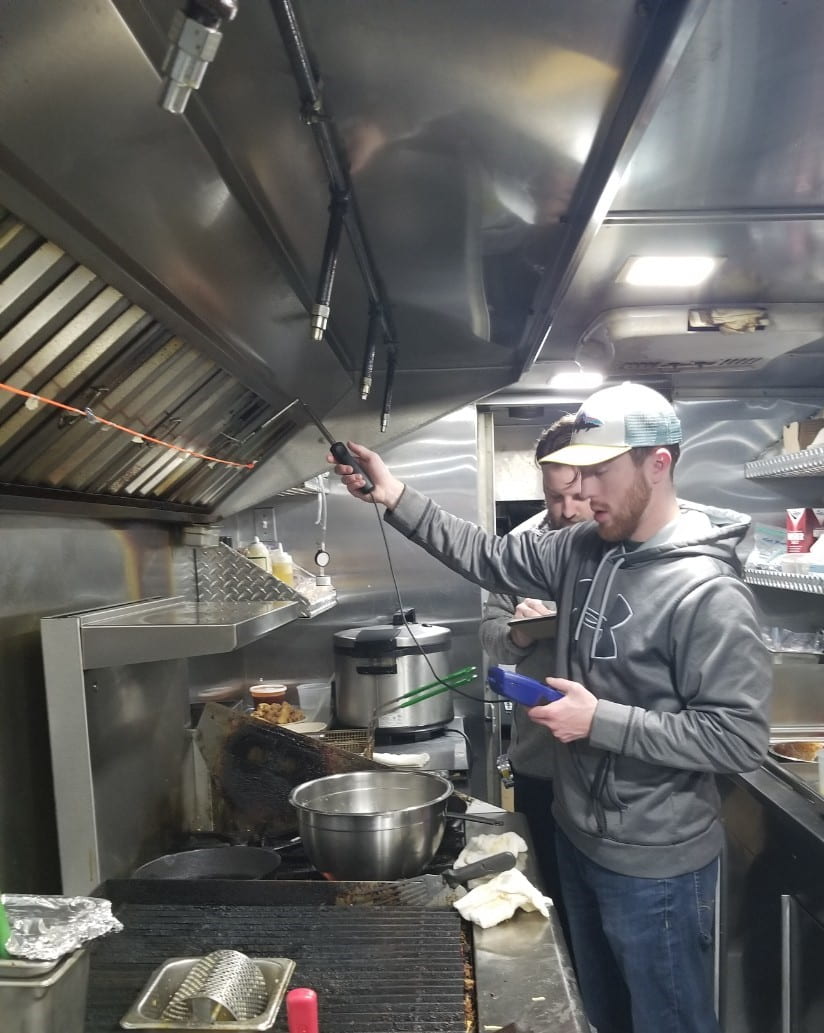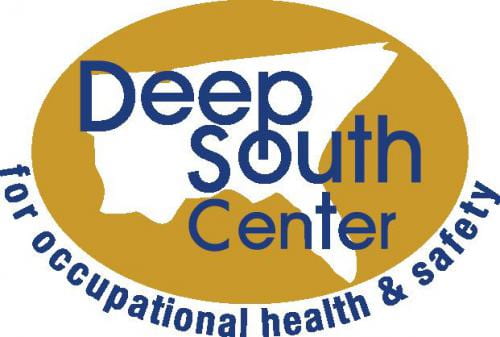DSC Blog, Food Truck Safety
Evaluation of Aldehydes, Polycyclic Aromatic Hydrocarbons, and PM2.5 Levels in Food Trucks
A Pilot StudyHolden Phillips, MPH and Jonghwa Oh, PhD
Background: The food truck industry has rapidly expanded in the United States and kitchen environments can contain harmful contaminants from cooking emissions. The objective of this study was to examine the levels of aldehydes, polycyclic aromatic hydrocarbons (PAHs), and Particulate Matter (PM) 2.5 generated from cooking process in food trucks.
Findings: Formaldehyde was the only aldehyde detected in all samples with a concentration range of 7.16 to 53.68 μg/m3. No PAHs were detected above the limit of quantification. Average PM 2.5 concentrations ranged from 0.65 to 7.03 mg/m3. Food Trucks 1 and 2 have an average exhaust flow rate of 211 and 215 L/s per linear meter of hood, respectively.
Methods: Area sampling was performed twice at two participating food trucks during work shifts. Nine aldehydes and eighteen PAHs were analyzed according to the relevant standard methods while PM 2.5 was measured with a real-time monitor. Ventilation performance of the food truck exhaust hoods was also investigated using a thermal anemometer.
Conclusions/Application to practice: Overall, Food Truck 2 had consistently higher levels of aldehydes and PM 2.5 with comparable ventilation performance as Food Truck 1. The higher exposure levels of Food Truck 2 could possibly be attributed to a larger volume of food orders and the heavy duty cooking equipment with an exhaust flow rate below the American Society of Heating, Refrigerating and Air-Conditioning Engineers (ASHRAE) recommendations. Although more investigations need to be performed, the findings could be used to raise awareness of food truck workers and health practitioners to reduce potential exposure risks.
Applying Research to Occupational Health Practice
The food truck industry in the United States has rapidly expanded in the past few years. Food truck environments are unique workplaces where workers use diverse thermal cooking appliances in a very limited space. In this pilot study, we examined the levels of contaminants generated through the cooking process within food trucks, including PM 2.5, aldehydes, and PAHs. In addition, the performance of the ventilation system of food trucks was also investigated. Our findings suggest potential exposure to formaldehyde and PM 2.5 with inadequate ventilation especially in a busier food truck, that is, higher emission and lower exhaust flow rate. Although more investigations need to be performed, the findings could be used to raise awareness of food truck workers and health practitioners to reduce potential risks of such exposures. Relatively simple engineering controls to improve the C&C efficiency of the existing ventilation system such as adding side panels to the hood and decreasing setback of the hood could be implemented wherever applicable.
AUTHOR BIOGRAPHIES
Holden Phillips, MPH is an industrial hygienist/safety technician at AMERICAN Cast Iron Pipe Company headquartered in Birmingham, Alabama. He earned an MPH degree at University of Alabama at Birmingham (UAB) with a focus on industrial hygiene in 2019.
Jonghwa Oh, PhD is an assistant professor in the Department of Environmental Health Sciences at UAB. She earned a PhD in environmental health sciences (industrial hygiene track) from UAB. Her main research area is on improving occupational exposure assessment and control methods.

Author’s Note: This study does not represent the views of the authors’ affiliations and its contents are solely the responsibility of the authors and do not necessarily represent the official views of National Institute for Occupational Safety and Health (NIOSH).
Funding: The author(s) disclosed receipt of the following financial support for the research, authorship, and/or publication of this article: This study was supported in part by The Deep South Center for Occupational Health and Safety (Grant #T42OH008436 from NIOSH).
ORCID iD: Jonghwa Oh https://orcid.org/0000-0002-6017-0963
Supplemental Material: Supplemental material for this article is available online.
DSC Faculty News
More Congratulations…
 Dr. Mark Schall and J. Michel, were awarded Best Paper in the Occupational Ergonomics Technical Independent Research Category at the 64th Annual Meeting of the Human Factors and Ergonomics Society; 2020 October 5-9, in Chicago, IL for their paper: Leadership Styles in Participatory Ergonomics Programs: A Bibliometric Analysis.
Dr. Mark Schall and J. Michel, were awarded Best Paper in the Occupational Ergonomics Technical Independent Research Category at the 64th Annual Meeting of the Human Factors and Ergonomics Society; 2020 October 5-9, in Chicago, IL for their paper: Leadership Styles in Participatory Ergonomics Programs: A Bibliometric Analysis.
Publications:
N. Gupta, V. Kozlovskaya, M. Dolmat, B. Yancey, J. Oh, C. T. Lungu, E. Kharlampeiva. 2020. Photocatalytic Nanocomposite Microsponges of Polylactide-Titania for Chemical. Remediation in Water. ACS Appl. Polym. Mater. 2(11): 5188-5197
Mishra S, McClure L, Golla V, Guddattu V, Lungu CT, Sathiakumar N. 2020. Relationship between Diabetes Mellitus and Indoor Air Pollution: an Exploratory Analysis. International Journal of Noncommunicable Diseases. 5(4):165-170. DOI: 10.4103/jncd.jncd_38_20
Bani Hani D, Huangfu R, Sesek RF, Schall Jr MC, Davis GA, Gallagher S. (2020). Development and Validation of a Cumulative Exposure Shoulder Risk Assessment Tool Based on the Fatigue-Failure Theory. Ergonomics. doi: 10.1080/00140139.2020.1811399
Chen H, Schall Jr MC, Fethke NB. (2020). Measuring Upper Arm Elevation using an Inertial Measurement Unit: An Exploration of Sensor Fusion Algorithms and Gyroscope Models. Applied Ergonomics, 89, 103187. doi: 10.1016/j.apergo.2020.103187
Schall Jr MC, Chen Peter, Evidence-Based Strategies for Improving Occupational Safety and Health among Teleworkers During and After the Coronavirus Pandemic, Human Factors, https://doi.org/10.1177/0018720820984583
Yousif Abulhassan, Gerard A. Davis, Considerations for the transportation of school aged children amid the Coronavirus pandemic. Transportation Research Interdisciplinary Perspectives, Elsevier.
Mark C. Schall Jr., Xuanxuan Zhang, Howard Chen, Sean Gallagher, Nathan B. Fethke, Comparing upper arm and trunk kinematics between manufacturing workers performing predominantly cyclic and non-cyclic work tasks, Applied Ergonomics, Volume 93, May 2021, 103356.
S. Shedd*, A. J. Hauser, W. W. Keuhaster, S. Ranjit, E. L. Floyd, J. Oh, C. T. Lungu. Determining the Thermal Properties and Buckypapers used in Photothermal Desorption. In review
R. Thaper, J. Oh, R. Sesek. Performance of Smart Device Noise Measurement Applications: A Literature Review. In review.
PROJECTS:
OHN Program Director, Dr. Karen Heaton and her team leveraged a formal clinical partnership with UAB Medical Center (UABMC). This resulted in scholarly projects completed by OHN’s first two DNP graduates: Chris Stallard, Identifying and decreasing sharps injuries through root cause analysis in a large urban hospital system; and Josh Ades and Chris Smith, Anesthesia provider diversion prevention: A knowledge and needs gap analysis.
Dr. Mark Schall, is the co-PI of a contract through the US Army Natick Soldier Systems Center that aims to systematically evaluate lower extremity motor adaptations for joint actuation.
COVID-19 and the DSC
COVID-19 and the DSC
The DSC continues to work with trainees, businesses, and stakeholders—improving processes and assuring safety as the COVID-19 pandemic continues. All of our programs have been invested in efforts to protect workers over the last 9 months. UAB Occupational Health Nursing (OHN) faculty have provided direct care to COVID patients. Also, in OHN one of the recent research projects on Long-haul Trucking has also incorporated COVID. Meanwhile, the Auburn OSE/OIP faculty and students have been working on a vaccination process improvement project—as well as creating hazard labels for a distillery. The AU team also conducted a safety-based risk analysis on a CPAP to ventilator converter in response to the pandemic. In IH, the faculty and students continue to work with activated carbon fibers in respiratory protection and creating a fit matching app for eye protection. The IH Lab also set up testing for N95 efficiency after disinfection. The Continuing Education program successfully completed a project providing respiratory fit testing workshops to over 300 employees of the Alabama Nursing Home Association.
Graduation/New Students
Congratulations and Welcome!
Savannah Jones graduated with her MPH in Industrial Hygiene in December!
At Auburn, Warner Brines and Corey Geter completed the OSE Graduate Certificate Program. Congratulations!
The DSC welcomes our new students:
Jasna Rosser-Williams
Kelvin Dam
Rachel Michel
Southeast Mine Safety and Health
The Southeast Mine Safety and Health Conference Team wants to stay connected with you. So we had Dr. Kevin Elko one of our most popular speakers record a special message for you. Feel free to use this video in a safety meeting or share it with your team. Also remember to mark your calendar for the November 3-5, 2021 Southeast Mine Safety and Health Conference in Birmingham, AL registration will be posted in 2021 on our website. Enjoy the video!
The 2020 Southeast Mine Safety and Health Conference has been postponed but will occur in November 2021. This decision did not come easily and was made weighing all the available information. This was the correct decision given the unknowns, potential health risk to attendees, exhibitors, and speakers as well as the finical sustainability of the conference’s moving forward.
We are looking forward to seeing you at the 2021 Southeast Mine Safety and Health Conference. As well as many conferences in the future.
Please mark your calendars for the 2021 Southeast Mine Safety and Health Conference. Starting with Pre-Conference and Golf options on November 2, 2021 then the Conference on November 3 – November 5, 2021.
- Sponsors make the conference possible. Make your sponsorship donation today and we will post your logo on our website now.
- Booking 2021 Exhibitors Now! See the current 2021 Exhibitors CLICK HERE. To get the best booth possible for 2021 CLICK HERE.
- 2021 Attendee registration is not open at this time. Once Attendee registration opens we will post on our website and send an email out.
- We want to stay engaged with you. Connect with our social media channels below. Also visit our website https://southeastmineconf.org/ for more updated information.
2020 Pilot Project Recipients
One-Handed Carrying on Flat and Inclined Surfaces
Duha Ali,(PhD student)/ Mark Schall PhD(Advisor)
Auburn University
Obesity has been strongly associated with work-related injuries. In particular, obese individuals have been identified as being more susceptible to work-related musculoskeletal disorders (MSDs) caused by load-carrying when compared to healthy individuals. One-handed carrying is considered one of the most fatiguing and physically demanding methods of load carrying. Performing one-handed carrying tasks on inclined surfaces has not been adequately considered in previous research studies. In manual material handling jobs, employees must be able to perform tasks without excessive stress relative to their capability. Cardiorespiratory fitness is a measure of the body’s maximal ability to transport and use oxygen to perform physical work. Physiological measurements provide an objective scale on which to compare physical tasks with respect to the stress. The objective of this proposed study is to compare the physiological and psychophysical responses of obese and healthy individuals performing different one-handed carrying tasks on flat and inclined surfaces.
Occupational Exposure Assessment of Food Truck Environments: Aldehydes, Respirable particles, and Ventilation Performance
Jonghwa Oh, PhD, Assistant Professor
University of Alabama at Birmingham
Food truck environments are unique in that various thermal cooking appliances creating various degrees of thermal plume are used in a very limited space, often without periodic ventilation performance checks. Food truck industry in the U.S has rapidly expanded with an annual growth of 6.8 % in the past five years1. The work environment of this emerging occupation however has not been investigated by other researchers to date while cooking emissions can contain harmful contaminants such as fine/ultrafine particles, polycyclic aromatic hydrocarbons (PAHs), and aldehydes. In our pilot study performed in two local food trucks (Evaluation of Aldehydes, Polycyclic Aromatic Hydrocarbons, and PM2.5 Levels in Food Trucks, in press as of March 19, 2020), several aldehydes and relatively high PM2.5 concentrations were found with inadequate ventilation performance while no PAHs were detected among analyzed air samples. Based on our findings and scientific literature, we propose to evaluate the food truck workers’ exposure by examining eight aldehydes, respirable particles, and ventilation performance and to implement controls where necessary and applicable.
Comparing nitrogen dioxide concentrations in homes using biomass stoves to homes using liquefied petroleum gas stoves as part of a multi-country cookstove study
Katherine Ann Kearns, PhD Student,
University of Georgia
Billions of people around the globe are impacted by household air pollution (HAP) through the use open fires inside their homes for heating and cooking, and these fires are fueled by inefficiently burning materials such as wood, crop residues, and coal (collectively referred to as “biomass”)1,2. The majority of people exposed to HAP in the form of biomass reside in lower- and middle-income countries (LMICs), but exposure disproportionately affects women and children, as they are the ones that typically spend the most time near the fire, with a child’s exposure often starting before birth3,4. Exposure to HAP is attributable to an estimated 4 billion premature deaths every year and is associated with many adverse health outcomes including low birth weight, respiratory infections, cancer, and pneumonia, which is a major killer in children under five years of age1-4. In addition to fine particulate matter (PM2.5) and carbon monoxide (CO), nitrogen dioxide (NO2) is another pollutant of interest in HAP settings that is understudied. Consequently, investigators of the Household Air Pollution Intervention Network (HAPIN) wish to incorporate the personal and area assessment of NO2 concentrations in a subset of participants from the parent study. This ancillary NO2 study will inform on the efficacy of cleaner cookstoves to sufficiently reduce NO2 levels in accordance with health-based standards.
Understanding Secondary Traumatic Stress of Emergency Nurses & associated patient outcomes
Michael Callihan, PhD, Assistant Professor,
University of Alabama
In the fast-paced environment of the Emergency Department (ED), nurses are often tasked with caring for multiple patients at one time that easily decompensate and progress from sick or injured, to critically ill within a matter of minutes. The high stress placed on the nurse is suspected to perpetuate the missing of imperative clinical cues which could be mitigated early and prevent the patient from declining. This high-pressure environment, coupled with the missed cues and deterioration of patients is thought to cause traumatic experiences for the ED nurse progressing to burnout, compassion fatigue, and Post-Traumatic Stress Disorder (PTSD). Secondary traumatic stress is associated with the emotions and behaviors of people who care for others that have experienced a traumatic event [1]. The emotional effects of the secondary exposure often mimics the effects seen in the individual who experienced the trauma directly. These emotional effects are experienced by ED nurses every day [2], and can have psychological effects leading to PTSD, burnout, and compassion fatigue [3-5]. While ED nurses never back away from the care of any patient, the question remains as to what we are doing to limit the exposure to this occupational risk. The Purpose of this pilot study is to explore the connection between the high-stress environments of the emergency department and missed clinical cues of patient deterioration to the development of secondary traumatic stress and PTSD among ED nurses.
Effect of Exoskeleton and Temperature Level on Construction Worker Fatigue
Chukwuma Aham Nnaji, Assistant Professor
University of Alabama
Construction workers are prone to musculoskeletal disorders from overexertion and working under extreme temperatures. One solution that has been identified by many, including the National Institute for Occupational Health and Safety (NIOSH), is the use of exoskeletons to reduce the impact of such activities and work conditions. Current work regarding exoskeletons, however, focuses primarily on rehabilitative rather than preventative uses leading to devices that exert too much force on the wearer, are impractical, uncomfortable, or unsafe for certain work-related applications. For an exoskeleton device to be designed most beneficially to the construction industry, it is crucial that it not only aid and protect the worker, but that it also responds to changing environments. Current exoskeleton research does not take into account the impact of critical environmental factors such as temperature change on exoskeleton performance. The work herein proposes to develop a method for assessing the effect of exoskeleton on physical demand in changing temperature – in a controlled environment and live field conditions. These assessments will rely on data obtained from monitoring parameters such as heart rate, skin temperature, core temperature, and electromyography (EMG). It is expected that an increase in temperature level will increase the level of physical demand when using the exoskeleton, leading to higher levels of discomfort. Work-related experiments focused on a small group of participants will generate data to test the methodology and the relationship between change in temperature and physical demand when using an exoskeleton. The data generated through this pilot work is expected to lead to future proposals through NIOSH and other funding mechanisms to expand the number of participants and include other factors that impact physical demand and worker fatigue.
Novel IR reflective coating onto textiles and fabrics for heat protection
Pillai R. Renjith, (Dr. Vinoy Thomas, Mentor)
University of Alabama at Birmingham
The atmospheric temperature shows a rapid increase in the recent years all around the world. The number of sunburn cases among workers is getting raised nowadays, i.e. Mainly because of the lack of proper aids to protect themselves from exposure to sun in the working hours. The focus is to promote productive workplaces without compromising the safety and health concerns. So, the predominant consideration should be given to their protection of workers from sun burn. The better way to protect workers is to modify the working dress with infrared reflective materials. The plasma processed nano surface is the best way for the same. The nano particle coating can be furnished aided with Cold Plasma technique. Plasma process can
in situ modify the surfaces with nanoparticles via plasma enhanced chemical vapour modification. The merit over cold plasma technique is that the temperature almost be in the range of 30˚C, that will help to keep the fabric safe and durable after the Cold Plasma Process and suitable to temperature sensitive materials too. The primary data proves that the plasma processed nano surface show more reflective nature towards infrared rays and is seems to be cooler than the unprocessed surface by approximately 11˚C. The size of particle produced by plasma technique can be confirmed with SEM and TEM and is seems to be in the range of 100-200nm, which will enhance the infrared reflection ability of the surface. The thermal and mechanical data also confirm the durability of fabric after Cold Plasma Process. All the preliminary data are promising in all aspects.
Save the Date! Southeast Region Research Symposium 2022
 The Southeast Region Research Symposium in which occupational safety and health researchers and students will present their work will be held following the Southeastern States Occupational Network (SouthON) symposium on March 21-23, 2022, Chapel Hill, North Carolina. This year’s event will be the fourth collaboration of SouthON and regional Education and Research Centers and Agricultural Centers. The other centers involved are: Central Appalachian Regional ERC, Sunshine ERC, Southeastern Coastal Center for Agricultural Health and Safety, North Carolina Occupational Safety and Health ERC and Southeast Center for Agricultural Health and Injury Prevention—representing Kentucky, Florida, North Carolina and Alabama.
The Southeast Region Research Symposium in which occupational safety and health researchers and students will present their work will be held following the Southeastern States Occupational Network (SouthON) symposium on March 21-23, 2022, Chapel Hill, North Carolina. This year’s event will be the fourth collaboration of SouthON and regional Education and Research Centers and Agricultural Centers. The other centers involved are: Central Appalachian Regional ERC, Sunshine ERC, Southeastern Coastal Center for Agricultural Health and Safety, North Carolina Occupational Safety and Health ERC and Southeast Center for Agricultural Health and Injury Prevention—representing Kentucky, Florida, North Carolina and Alabama.
Student Awards and Scholarships

DSC Industrial Hygiene students were honored by the American Association of Safety Professionals (ASSP) and the American Industrial Hygiene Foundation (AIHF).
Erin A. Lindsey, MPH student, ASSP Alabama Chapter Scholarship
Andrew K. Spivey, MPH student, AIHF Scholarship
Savannah Jones, MPH student, George and Florence Clayton Scholarship, AIHF
Nathen Chen, PhD student, Los Alamos Scholarship, AIHF
Occupational Safety Engineering student, Duha Ali, is working on a pilot project awarded through the DSC. Her focus is the physiological demands of one-handed carrying.
Covid-19 and DSC
COVID-19 and DSC
The DSC has been very active in helping with the COVID-19 pandemic. The IH program has been working with UAB Hospital to set up a testing system for checking the efficiency of N95 filtering face-piece masks after being decontaminated with silver ion-based hydrogen peroxide vapor.
At the solicitation of US Senator Richard Shelby’s office, Dr. Lungu provided information regarding the parameters needed for producing and testing N95 type masks in the state of Alabama. He also informed the office of the resources available within the DSC such as technical support and advice from the researchers, students and staff in the fight against COVID-19.
The DSC also played an active role within the School of Public Health at UAB, with both Allyn Holladay, Deputy Director and Director of CE and Outreach and Paulisha Holt, Outreach Director, participating in several COVID-19 driven committees to assure best practices for a safe and healthy environment for students, faculty and staff as they returned to campus.
Finally, the Alabama Nursing Home Association came to the DSC for training in Respiratory Protection. This was a state-wide effort that provided best practices and fit testing for over 400 professionals.


